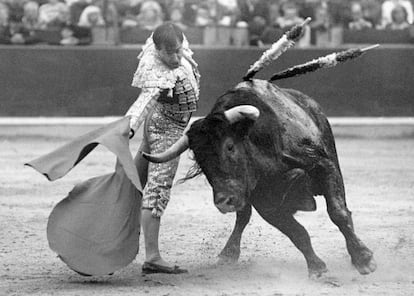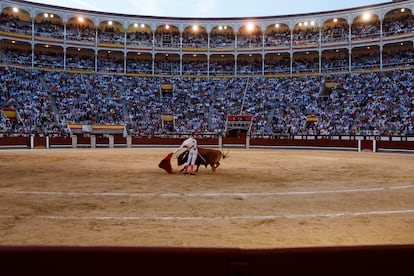On August 15, 1914, a Cultural and Anti-Bullfighting Festival was held in Gijón that brought together 4,000 people outdoors, in a relaxed and family atmosphere. It was convened by an anti-flamenco society that protects animals and plants, inspired by the ideas of Eugenio Noel, a famous opponent of bullfighting (and the banalization of flamenco) who toured Spain on agitation work. The historian Sergio Sánchez Collantes, professor at the University of Burgos, has dusted off this event by searching the archives: “Although not all left-wing people were anti-bullfighting, it was common for these ideas to circulate, with different nuances, in different left-wing political cultures. : republicans, socialists, anarchists and even reformists,” he says. The event was supported by numerous labor associations, with special attention to women: “You are the queens of life who display the august attributes of motherhood,” the call read. They were expected not to take their children to the bullfights. There were speeches, birds were released. “That was a mass mobilization by the standards of the time,” says the historian.
Eloy Alonso (EFE)
The festival was celebrated on Begoña Day, coinciding with the city’s bullfighting fair, which even in recent years, in the 21st century, has been controversial. In 2021, with great controversy, two bulls called Feminist y Nigerian: The then mayor Ana González, of the PSOE, announced that no more bullfights would be held. In 2023, the incoming mayor, Carmen Moriyón, of Foro Asturias, restored the bulls in the city. This story illustrates the tensions between bullfighting and anti-bullfighting passions that run through Spanish history. Because there is no doubt that the bullfighting festival is part of Spanish culture and traditions… but so is the opposition to bullfighting.
When discussing bullfighting, history and culture often come up. Names such as Lorca, Picasso, Hemingway or Goya are used to remember that they were either fans or, at least, represented bullfighting in their works. On the opposite side, names critical of the fight such as Jovellanos, Unamuno, Baroja or Quevedo. These arguments based on famous names are called authority arguments and they are a logical fallacy: that any of these characters supported or criticized bullfighting does not say anything definitive about the matter. But that does not mean that a line of confrontation between bullfighting and anti-bullfighting cannot be traced through the history of Spanish culture and thought.

“They have wanted to present anti-bullfighting positions as something new, a passing fad, something banal like the song of the summer, but anti-bullfighting has had strong roots in the history of Spain,” explains Juan Ignacio Codina, author of Bread and bulls: Brief history of Spanish anti-bullfighting thought (Plaza and Valdés). In his work he traces critical positions with bulls at least until the reign of Alfonso From there, through the centuries, Codina finds a line that allows him to outline what he calls a “general theory of Spanish anti-bullfighting thought”, and that goes through the Renaissance, the Enlightenment or regenerationism and the Generation of ’98, until the present.
“There are a series of arguments that are repeated over and over again, and a series of authors that rely on each other over time,” says the researcher, who this month launches Antitauropedia. Historical dictionary of anti-bullfighting thought (Plaza and Valdés). Among these arguments are cruelty towards animals, the brutalization of society, the spending of public money or the bad external image of Spain. The bullfighting arguments that have been put forward historically have to do with the traditional and identity-based character of the bullfight, the economic stability of the sector or its aesthetic and cultural value.

The relationship between bullfighting and the Enlightenment, for example, was discussed by the late philosopher Jesús Mosterín in his book In favor of the bulls (Laetoli), arguments that he recounted in a well-known appearance in the Parliament of Catalonia, as an expert, when the ban on bullfighting was being debated in 2010. There, in addition to explaining the difference between ethics and morality, and describing moral progress as a purification of rejectable traditions, Mosterín pointed out that there was nothing specifically Spanish about the bullfight: “Throughout Europe there were bullfights (… ), but there was a process called the Enlightenment and that tended to cleanse cultures by eliminating their most sordid, cruelest or superstitious aspects.” There were only a few left cruelty bags, in the words of the philosopher José Ferrater Mora, in some places such as Spain and the south of France. In Spain, the enlightened Jovellanos (by the way, a native of Gijón) is frequently cited as a detractor of bullfighting, which he considered against morality and civilization, as a barbaric custom.
If in history we see a continuous ringing of the same arguments, there are those who conceive them chronologically, as a series of waves. It is the idea of Beatriz Badorrey, defender of bullfighting and author of Bullfighting / anti-bullfighting. A historic debate (Chair). First, before the Enlightenment, he points out humanist and moral arguments, which criticize the loss of human life and the dissolute life that bullfights foster in the town. Then, in enlightened times, the argument is made economically: the expense of the bullfights, the distraction they produce or the bad image abroad. Later, at the end of the 19th century, animalist arguments began to arrive that prioritized animal suffering.

“The bullfighting arguments have been in rhythm, trying to refute the criticism of the anti-bullfighting crowd at every moment,” says Badorrey. Thus, in parallel, it was first confirmed that the bullfights were not chaotic and immoral, then that they generated an economy and then that the breeding of the bull benefited the environment, maintained the species and generated the pastures. “It is argued that the bull is the animal that lives best: all cattle grow to die, but the bull lives in a lot of space, cared for, like an elite athlete,” says the researcher.
And so the story went from one side to the other. The regenerationists and the Generation of ’98, at the end of the 19th century, harshly criticized the bulls, because they saw in them a symbol of Spain in decline that had to be rebuilt. Already in the 20th century, some members of the Generation of ’27 saw bullfighting favorably, and the philosopher Ortega y Gasset took bullfighting into consideration and wrote, in a famous quote, that the history of Spain cannot be understood without this discipline. .
The debate about bulls is still in the air. 45% of Spaniards think that bullfighting should be prohibited, 24% that they should be encouraged, and 30.3% that they should not be prohibited but not encouraged either, according to a 2023 Electomanía survey. In the field of popular culture There are some notable figures who defend bullfighting, such as Joaquín Sabina, Miguel Bosé or Andrés Calamaro, as well as philosophers such as Fernando Savater. And it is a hot debate, as the controversy surrounding the cancellation of the National Bullfighting Award by the Minister of Culture, Ernest Urtasun, once again demonstrated. “Spain has reached a moment of political and social maturity, and bullfighting is pointed out as one of the burdens that prevent our country from becoming completely European,” says Codina.
On the other side, bullfighters wave the flag of culture and freedom. “We fans are not crazy, nor sadistic, nor are we going to see cruelty. We believe that there is beauty in bullfighting and we want to preserve a very rich cultural heritage. We only ask that we be understood and respected,” says Badorrey, who also points out that more deep thinking is needed in this area. “The university should approach this phenomenon from fields such as sociology or anthropology, among others. There is a lack of academic production,” he concludes.
Subscribe to continue reading
Read without limits
_

